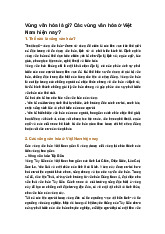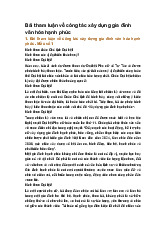





Preview text:
Official Name: United Kingdom of Great Britain & Northern Ireland
Parts: England, Scotland, Wales, Northern Ireland Total population: 66, 870, 000 Capital City: London
Type of Government: Constitutional monarchy Flag: The Union Flag Money: Pound sterling (£)
Highest mountain: Ben Nevis (1,343m, Scotland)
Longest river: River Severn (354 km, Wales)
Major languages: English, Welsh (about 26% of the population of Wales), Scottish (as a
form of Gaelic, about 60,000 in Scotland)
Total land area (sq.km): 244,820 sq. km
Major rivers: Thames, Severn, Tyne
Khí hậu: Varied climate
variable climate changing from day to day
difficult to predict the weather
warm summers & cool winters Temperate maritime mild damp subject to frequent changes.
The main influence on the climate is close proximity to the Atlantic Ocean Northern latitude
the Gulf Stream (a warm current of the northern Atlantic Ocean) Land: South & East:
comparatively low-lying: flat plains or gently rolling hills No towering mountain ranges
No impressively large rivers, plains, forests
It lacks in grandeur it makes up for in a variety North & West:
Mountainous areas & flat areas have a great proportion of grassland fields with hedgerows in southern England.
The English and the Welsh don’t like living in blocks of flats in city centers ⇒Cities have
been built outwards rather than upwards ENGLAND Population: 55,977,000
Area: 130,410 sq km largest of the countries comprising the island of Britain, covering
about two-thirds of the island. No place in England is more than 120 km from the sea. LONDON - Capital of the UK
The largest city in Britain & in western Europe
Home to headquarters of all government departments country’s parliament major legal institutions the monarch
Country’s business & banking Centre
Centre of its transport network.
Headquarters of national television networks & national newspapers.
About 7 times larger than any other city in the country
About a fifth of the total population of the UK lives in the wider London area.
Nearly a million people travel to the Centre each day to work. Southern England Outer suburbs of London
Most densely populated area The reputation of being 'commuter and millions of its
inhabitants travel into London to work every day.
Counties of Southern England Bristol Hampshire West Wiltshire Sussex Cornwall Isle of Berkshire Wight East Devon Sussex Gloucester Oxford shire Dorset shire Kent Surrey Somerset The Midlands of England Birmingham:
Second-largest city develops into the country’s major engineering center converting iron
& steel into a vast variety of goods.
Other industrial areas in the Midlands
develop The Potteries in Manchester
famous for producing China: factories of Wedgwood, Spode & Minton
world's greatest fishing port in Grimsby
country's major fish processing centre Northern England
Run up the middle of northern England like a spine.
The western side, the world's leading producer of cotton goods in the Manchester area in the 19th century
Eastern side, world's leading producers of goods in Bradford & Leeds woolen
Other towns sprang up on both sides of the Pennines concentrating on certain auxiliary
industries or on coal mining.
Further south, the center for the production of steel goods in Sheffield
Further north, shipbuilding - major industry - around Newcastle.
The Lake District (north-western corner of the country)
(the ‘Lake Poets’) Romantic poets: Wordsworth, Coleridge & Southey
favorite destination walking holidays
classified as a National Park (largest in England). Scotland In north-west Europe Part of Great Britain
An island country & the United Kingdom Area: 78,789 sq km Population: 5,438,000 Capital City: Edinburgh
Major Cities: Aberdeen, Dundee, Glasgow
Highest point: Ben Nevis (1,343 m)
Longest river: Tay (193 kilometers) long
Largest Lake: Loch Lomond (60 sq.km) 40 km long
-Three fairly clearly-marked regions: + Southern upland + Central plain + The highlands
Scotland's two major cities have very different reputations. Glasgow + Scotland's largest city
+ A strong artistic heritage, design, architecture
+ One of the world’s leading industrial Edinburgh
+ the capital and second-largest city of Scotland + Many historical buildings Wales In north-west Europe Part of Great Britain,
An island country & the United Kingdom(UK) Area:20,779 sq km Population:3,139,000 Capital City: Cardiff
Major Cities: Cardiff, Swansea & Newport
Highest point: Snowdon (1085 m) Longest river: Towy (103 km) Largest Lake: Bala (4.4 sq km)
Live in one small part of Wales
Most heavily populated in the south-east
Coal has been mined in many parts of Britain
locate its prototype coal mine in south Wales.
Cardiff - the capital of Wales – population: third of a million
Most of the rest of Wales is mountainous
Travel between south & north is very difficult.
Each part of Wales has closer contact with its neighboring: the north with Liverpool, &
mid-Wales with the English West Midlands. Belfast:
capital & largest city of Northern Ireland
famous for the manufacture of linen (still a shipbuilding city) Lough Neagh (Loch Neagh)
a freshwater lake in Northern Ireland
the largest lake by area in the British Isles




